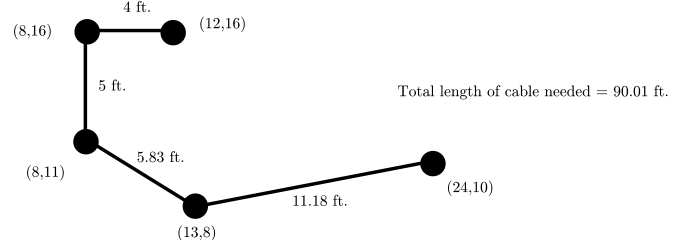原题:
Computer networking requires that the computers in the network be linked. This problem considers a “linear” network in which the computers are chained together so that each is connected to exactly two others except for the two computers on the ends of the chain which are connected to only one other computer. A picture is shown below. Here the computers are the black dots and their locations in the network are identified by planar coordinates (relative to a coordinate system not shown in the picture). Distances between linked computers in the network are shown in feet.

For various reasons it is desirable to minimize the length of cable used. Your problem is to determine how the computers should be connected into such a chain to minimize the total amount of cable needed. In the installation being constructed, the cabling will run beneath the floor, so the amount of cable used to join 2 adjacent computers on the network will be equal to the distance between the computers plus 16 additional feet of cable to connect from the floor to the computers and provide some slack for ease of installation. The picture below shows the optimal way of connecting the computers shown above, and the total length of cable required for this configuration is (4+16)+ (5+16) + (5.83+16) + (11.18+16) = 90.01 feet.

Input
The input file will consist of a series of data sets. Each data set will begin with a line consisting of a
single number indicating the number of computers in a network. Each network has at least 2 and at
most 8 computers. A value of 0 for the number of computers indicates the end of input.
After the initial line in a data set specifying the number of computers in a network, each additional
line in the data set will give the coordinates of a computer in the network. These coordinates will be integers in the range 0 to 150. No two computers are at identical locations and each computer will be listed once.
Output
The output for each network should include a line which tells the number of the network (as determined by its position in the input data), and one line for each length of cable to be cut to connect each adjacent pair of computers in the network. The final line should be a sentence indicating the total amount of
cable used. In listing the lengths of cable to be cut, traverse the network from one end to the
other. (It makes no difference at which end you start.) Use a format similar to the one shown in the
sample output, with a line of asterisks separating output for different networks and with distances in feet printed to 2 decimal places.
Sample Input
6
5 19
55 28
38 101
28 62
111 84
43 116
5
11 27
84 99
142 81
88 30
95 38
3
132 73
49 86
72 111
0
Sample Output
Network #1
Cable requirement to connect (5,19) to (55,28) is 66.80 feet.
Cable requirement to connect (55,28) to (28,62) is 59.42 feet.
Cable requirement to connect (28,62) to (38,101) is 56.26 feet.
Cable requirement to connect (38,101) to (43,116) is 31.81 feet.
Cable requirement to connect (43,116) to (111,84) is 91.15 feet.
Number of feet of cable required is 305.45.
Network #2
Cable requirement to connect (11,27) to (88,30) is 93.06 feet.
Cable requirement to connect (88,30) to (95,38) is 26.63 feet.
Cable requirement to connect (95,38) to (84,99) is 77.98 feet.
Cable requirement to connect (84,99) to (142,81) is 76.73 feet.
Number of feet of cable required is 274.40.
Network #3
Cable requirement to connect (132,73) to (72,111) is 87.02 feet.
Cable requirement to connect (72,111) to (49,86) is 49.97 feet.
Number of feet of cable required is 136.99.
中文:
让你用一条线状网络把所有电脑连接起来,要求用的网线总长度最短,每连接两个电脑要多余出16米。
#include <bits/stdc++.h>
using namespace std;
const double inf=99999999;
struct coor
{
double x,y;
};
double dist(coor a,coor b)
{
return sqrt((a.x-b.x)*(a.x-b.x)+(a.y-b.y)*(a.y-b.y))+16.00;
}
bool vis[10];
coor co[10];
int troad[10],road[10];
int n;
double ans;
void dfs(double tot,int cnt)
{
if(cnt==n)
{
if(tot<ans)
{
ans=tot;
for(int i=0;i<n;i++)
road[i]=troad[i];
}
return;
}
if(tot>=ans)
return;
for(int i=0;i<n;i++)
{
if(!vis[i])
{
troad[cnt]=i;
vis[i]=true;
if(cnt==0)
dfs(0,cnt+1);
else
{
double dis=dist(co[troad[cnt]],co[troad[cnt-1]]);
dfs(tot+dis,cnt+1);
}
vis[i]=false;
}
}
}
int main()
{
ios::sync_with_stdio(false);
int k=0;
fstream in,out;
// in.open("data.txt");
// out.open("output.txt");
while(cin>>n&&n)
{
ans=inf;
memset(vis,false,sizeof(vis));
memset(road,-1,sizeof(road));
memset(troad,-1,sizeof(troad));
for(int i=0;i<n;i++)
cin>>co[i].x>>co[i].y;
dfs(0,0);
cout<<"**********************************************************"<<endl;
cout<<"Network #"<<++k<<endl;
for(int i=1;i<n;i++)
{
cout<<"Cable requirement to connect ("<<fixed<<setprecision(0)<<co[road[i-1]].x<<","<<co[road[i-1]].y<<") to ("<<co[road[i]].x<<","<<co[road[i]].y<<") is "<<fixed<<setprecision(2)<<dist(co[road[i-1]],co[road[i]])<<" feet."<<endl;
}
cout<<"Number of feet of cable required is "<<fixed<<setprecision(2)<<ans<<"."<<endl;
}
// in.close();
// out.close();
return 0;
}
解答:
思路非常简单,但是好长时间没写带代码了,尤其是dfs,wa了好几次=_=
用深度优先搜索遍历所有情况,注意,所有情况的时候不要把起始点标记成已经遍历过(vis[1]=true)
这里面有个很简单的剪枝,就是如果连接网络连接到一半的时候可以检查一下目前的费用,和之前得到的完整路径的结果做比较,如果连接到一半就比之前的费用大,那么就不用继续枚举了。






















 994
994

 被折叠的 条评论
为什么被折叠?
被折叠的 条评论
为什么被折叠?








